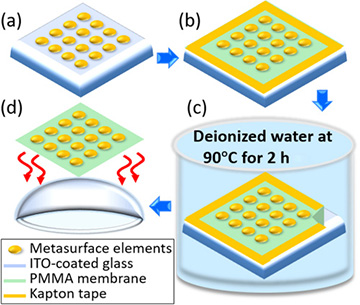
Color perception of a scenario viewed with normal vision (left), deuteranomaly (middle), and deuteranomaly corrected with the new contact lens (right). [Image: Sharon Karepov, Tel Aviv University]
Contact lenses are a comfortable, invisible and customizable solution for correcting refractive errors—seeing 20/20 is as easy as popping in a lens. Yet applying the same solution to other vision disorders has proved difficult.
Now, Researchers at Tel Aviv University in Israel have devised a nanofabrication process for embedding metasurfaces onto the curved surface of a contact lens, resulting in customizable lenses that can correct a common form of color blindness by up to a factor of 10 (Opt. Lett., doi: 10.1364/OL.384970).
Correcting color perception
Deuteranomaly—green/red color blindness—is a relatively common condition, affecting around 8% of men (but less than 1% of women), that causes difficulty in distinguishing between red and green colors and their combinations. This happens when the sensitivity of the eye’s green cone photoreceptor is redshifted—as a result, the excitation of the spectrum related to red illumination becomes more pronounced.
This excessive excitation can be treated with color filters to improve color perception, and glasses with color filters are commercially available. But devising customizable, sustainable contact lenses that accomplish the same goal has been a harder case to crack.
The Tel Aviv researchers—including Sharon Karepov and Tal Ellenbogen of the school’s department of physical electronics—turned to plasmonic metasurfaces as a promising material for their customizable, comfortable and durable color filters. The ultrathin films are made of “subwavelength building blocks,” the researchers write, “that enable tunable control over their optical response.” By taking advantage of these wavelength-selective features, metasurfaces can act as tailor-made color filters and shift back incorrectly perceived pigments.
Immerse and peel

Immerse and peel process for embedding metasurfaces into contacts. (a) Metasurface, fabricated by conventional electron beam lithography, on a glass substrate. (b) PMMA A4 spin coat on the metasurface, followed by bake. Kapton tape is used to frame support. (c) Immersion of the element in deionized water at 90 °C for 2 h. (d) PMMA membrane is peeled away and thermal fusion of it to the lens. [Image: From S. Karepov and T. Ellenbogen, Opt. Lett. 45, 1379 (2020)]
One big hurdle for the team to clear was that metasurfaces are fabricated on flat surfaces, and are difficult to transfer to curved ones. To circumvent this, the researchers devised an “immerse and peel” technique for constructing the ultrathin metasurface film and embedding it onto a curved lens.
Using electron beam lithography, the team constructed a 40-nm-thick metasurface made of gold nanorods on top of an indium–tin–oxide (ITO)-coated glass. The researchers then applied a spin coating of PMMA—a transparent thermoplastic—and baked the metasurface for a few minutes, providing a strong adhesive matrix. They then immersed the metasurface stack in deionized water. After two hours of soaking, the metasurface film was peeled away from the glass substrate and thermally fused to a rigid contact lens.
With this technique, the plasmonic metasurface is sandwiched between the contact lens on the bottom and the PMMA layer on top—protecting the optical properties of the metasurface layer. Transmission spectra measurements confirmed that the light-manipulation features of the metasurface were unchanged once transferred to the curved surface.
Simulating color blindness
To test their lenses, the researchers used the transmission-spectrum measurements to simulate the contacts’ effect on color perception in the case of deuteranomaly. Using an algorithm, they took the color-perception matrices of each condition—normal vision, deuteranomaly and contact-lens-corrected deuteranomaly—and calculated how test pigments would be perceived under each condition. The maximum improvement in color-perception error calculated was by a factor of 10.
Another test was based on an existing vision test for color blindness—the Ishihara-based color perception test, which shows a green plate with a vanishing red design that can only be seen by those with normal vision. In this experiment, the red design was perceptible after simulating the application of the corrected lens, which according to the team, indicates the visual contrast was restored.
The researchers note that the technique could be expanded beyond color blindness to correct for other vision deficiencies by engineering the metasurfaces to exhibit polarization-selective filtering or other optical-manipulation properties. Therefore, the researchers write, “embedding metasurfaces into contact lenses may open the door for tailor-designed new visual functionalities.”
